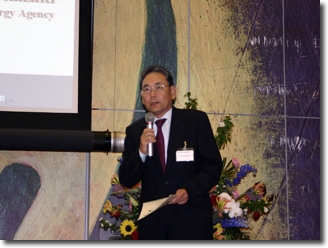The International Nuclear Nonproliferation Science and Technology Forum
Opening Address / Opening Remarks
At the beginning of the Forum, Mr. Yuichi TONOZUKA, President of Japan Atomic Energy Agency (JAEA) delivered an opening address.
He emphasized the necessity of appropriate actions reflecting international nuclear nonproliferation circumstances in order to promote peaceful use of nuclear energy. He then expressed his expectations that the forum would provide an ideal opportunity to improve understanding of current international trends as well as to consider Japan's approach and JAEA' s role toward the peaceful use of nuclear energy and nuclear nonproliferation.
The opening address was followed by opening remarks by Mr. Saburo KOUMOTO, Senior Vice Minister of Education, Culture, Sports, Science and Technology. His remarks were as follows;
Resource-poor Japan actively promotes nuclear energy, especially the nuclear fuel cycle and fast breeder reactors, since nuclear energy maintains stable energy supply and avoids emission of carbon dioxide. At the same time, Japan accepts IAEA Safeguards according to the international agreement. Japan also promotes the strengthening of international nuclear nonproliferation regime and international Safeguards.
The current nuclear nonproliferation regime, however, is recognized as a serious global issue of common concern. The international nuclear nonproliferation systems and technologies are required to be reviewed from various aspects. Japan is willing to be involved in such review based on its Safeguards experience and technical expertise. I believe that this Forum hosted by JAEA has a significance meaning in exchanging views on the peaceful use of nuclear energy and nuclear nonproliferation among government officials and experts from various countries in the world.
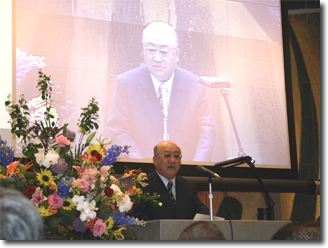
Opening Address
(Mr. Tonozuka, President, Japan Atomic Energy Agency)
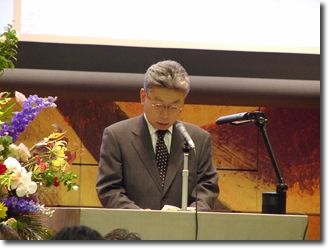
Opening Remarks
(Mr. Koumoto, Senior Vice Minister, Ministry of Education,Culture, Sports, Science and Technology)
Special Speech "Nuclear Non-Proliferation: Responding to a Changing Landscape"
Dr. Mohamed ElBaradei, IAEA Director General
(Dr. Olli Heinonen, IAEA Deputy Director General, reads Dr. Mohamed ElBaradei's speech on his behalf)
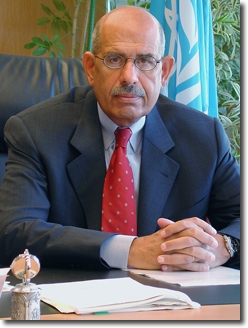
Dr. Olli HEINONEN, Deputy Director General of International Atomic Energy Agency (IAEA), made a speech entitled "Nuclear Nonproliferation: Responding to a Changing Landscape", on behalf of IAEA Director General Dr. Mohamed ElBaradei.
In the speech, he emphasized that the social, political and technological changes were needed to meet current nuclear nonproliferation challenges and he explained Dr. ElBaradei's proposal for better control of access to nuclear fuel cycle technology including an assurance of supply mechanism. He also stressed the importance of the physical protection of nuclear material, universalization of the Additional Protocol, strengthening of verification capability and securing the finance for human resources and Safeguards technology development.
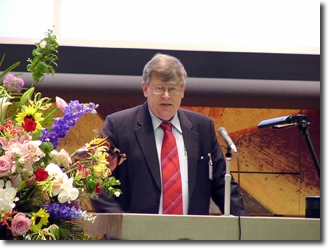
*This report on the Forum was edited by the Forum secretariat on its own responsibility. For details, please see distributed material.
Keynote Speech "Future Prospects of the Global Nuclear Partnership"
Mr. Jerry Paul, Principal Deputy Administrator, National Nuclear Security Administration, US Department of Energy (DOE/NNSA)
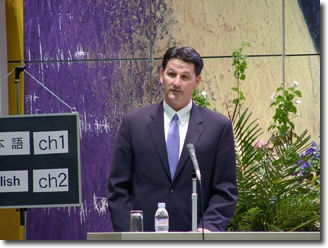
Mr. Jerry PAUL, Principal Deputy Administrator, National Nuclear Security Administration, US Department of Energy, highlighted the significance of the US Global Nuclear Energy Partnership, such as meeting globally growing energy demand, radioactive waste management and nuclear nonproliferation, in his speech entitled "Future Prospects of the Global Nuclear Energy Partnership, "He also explained GNEP's broad implementation strategy comprised of seven elements and called for international partnership in meeting the challenges under GNEP.
*This report on the Forum was edited by the Forum secretariat on its own responsibility. For details, please see distributed materials ([Slide], [Paper]).
Keynote Speech "Japan's Efforts toward Making the Peaceful Use of Nuclear Energy Compatible with Non-proliferation"
Dr. Yumi Akimoto, Chairman, Committee on Energy and Resources, Japan Business Federation Chief Executive Emeritus, Mitsubishi Materials Corp.
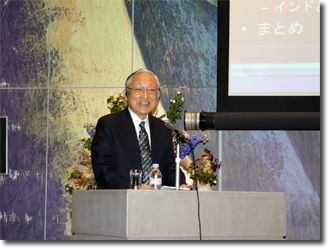
Dr. Yumi AKIMOTO, Chairman of the Committee on Energy and Resources, Japan Business Federation and the Chief Executive Emeritus of Mitsubishi Material Corp., explained Japan's nuclear energy policy under nuclear nonproliferation regime as well as Japan's efforts to ensure transparency and confidence in promoting nuclear energy in his speech entitled "Japan's Efforts toward Making the Peaceful Use of Nuclear Energy Compatible with Non-proliferation". He also stated his views on the assurance of supply mechanism, US GNEP and civil nuclear cooperation with India.
*This report on the Forum was edited by the Forum secretariat on its own responsibility. For details, please see distributed materials ([Slide], [Paper]).
Panel 1 "Future Prospects for Peaceful Use of Nuclear Energy and Nuclear Nonproliferation in the World"
- Chairperson :
-
Prof. Masahiko ASADA Graduate School of Law, Kyoto University - Panelists:
-
Mr. Jerry PAUL Principal Deputy Administrator, National Nuclear Security Administration (NNSA), US Department of Energy (DOE) Dr. Alex BURKART Deputy Director, Office of Nuclear Energy, Safety and Security, Bureau of International Security and Nonproliferation, US Department of States (DOS) Mr. Takeshi NAKANE Ambassador / Director-General, Disarmament, Nonproliferation and Science Department, Ministry of Foreign Affairs of Japan Mr. Philippe DELAUNE Deputy Director for International Affairs, French Atomic Energy Commission (CEA) Mr. Vitaly FEDCHENKO Researcher, Stockholm International Peace Research Institute (SIPRI) Mr. Toshio OKAZAKI Executive Vice President, JAEA
(Note: This summary is edited by JAEA Nuclear Nonproliferation Science and Technology Center (NPSTC) on its own responsibility and it is not confirmed either by chairperson or panelists. Panelists expressed their views in their private capacity, although they are expressed by their own countries' names as a matter of convenience.)
Currently, the Nuclear Nonproliferation Treaty (NPT) regime is faced with many challenges and new ideas and approaches are needed to strengthen the nonproliferation regime based on the NPT for the peaceful use of nuclear energy. There are three initiatives which currently attract worldwide attention from a nuclear nonproliferation perspective: (1) an assurance of fuel supply mechanism, (2) the US Global Nuclear Energy Partnership (GNEP), and (3) civil nuclear cooperation with India, which is not a member state of NPT. The three initiatives were lively discussed in Panel 1 from various aspects such as their significances, effects, influences, challenges and themes for international cooperation.
(1) A Mechanism for assuring the supply of nuclear fuel
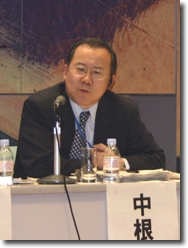
Mr. Takeshi Nakane
At the outset, the currently proposed four mechanisms for assuring fuel supply were introduced and their respective characteristics were briefly described as follows:
a) IAEA Director General Dr. ElBaradei's Multilateral Nuclear Approaches (MNA):
- Reliable multilateral fuel supply regime.
b) World Nuclear Association (WNA)'s approach:
- The approach would be applied only when market mechanisms have failed. The assurance of supply mechanism was designed as a back up solution.
- IAEA would determine a recipient state's eligibility for the mechanism. Recipient states would be judged eligible provided that it forgoes enrichment and reprocessing and abides by international Safeguards.
- Recipient states would receive nuclear fuel for commercial contracts under the guidance of supplier states and IAEA.
c) President Bush's nuclear nonproliferation initiative:
- This is a short-term mechanism to ensure that states which renounce enrichment and reprocessing can enjoy reliable access to nuclear fuel.
d) US Global Nuclear Energy Partnership:
- This has been built on President Bush's initiative with a long-term perspective and envisions a future design for backend measures.
Impacts on the nuclear nonproliferation regime, especially on the states concerned with nuclear weapon development:
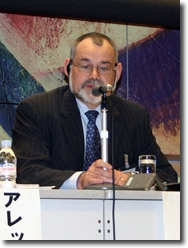
Mr. Philippe DELAUNE
One panelist observed that the assurance of supply mechanisms would not serve as a direct solution and that diplomatic measures should be taken to tackle with the problems posed by those states. Another panelist referred that mechanisms would not work for the case of DPRK, but their backend measures might attract Iran. On the other hand, another panelist mentioned that it would be too early to judge their effectiveness now, since they are not yet designed in detail.
Eligibility for the assurance - to forgo enrichment and reprocessing:
One panelist observed that every state has a right to access sensitive technologies including enrichment and reprocessing and that states must be in good compliance with Safeguards, export control and physical protection obligations under nuclear nonproliferation regime. Some panelists also stated that the mechanism should be elaborately designed to be acceptable by recipient countries.
Classification of "recipient states" and "supplier states":
One panelist asked about the classification of "recipient states" and "supplier states" and said the plan might worsen the inequality between "weapon states" and "non-weapon states" under NPT. In response to the question, another panelist stated that such inequality would be eliminated since nuclear fuel could be accessible to the states which had never received nuclear benefits before. He emphasized the global benefits rather than one single state's benefit.
On the other hand, one panelist suggested that the classification should not be locked up and that the assurance of supply mechanism should be flexible enough to allow "recipient states" to become "supplier states" in the future.
As to inequality under the NPT, one panelist proposed that civilian nuclear facilities in nuclear weapon states should be placed under IAEA Safeguards, in order to mitigate the inequality. He also suggested that the assurance mechanism should be associated with nuclear arms reduction, and that, for example, nuclear material resulted from arms reduction should be utilized for fuel supply so that the assurance mechanism could obtain wider understanding.
(2) Global Nuclear Energy Partnership (GNEP):
Radioactive waste management:
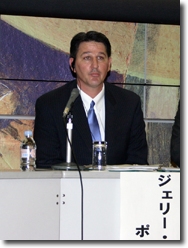
Mr. Jerry Paul
One panelist said that the recipient states should be responsible for their radioactive waste management, while supplier states should be responsible for the technology development which enables the reduction of environmental burdens. Another panelist, having said that supplier states should be responsible for their wastes now, asserted that the assurance of supply mechanism should be flexible enough both for recipient and supplier states to reconsider their respective responsibilities in view of the situation in the future. Some panelists stated that they should first see how the market would work on the waste management issue and that more discussions would be required, because detailed mechanisms for assuring the supply remain undecided and because there might be some possibilities for other solutions such as disposition in third states.
Reprocessing:
One panelist mentioned that the number of supplier states needs to be increased under certain conditions, since existing reprocessing capacity in supplier states would not be sufficient to reprocess all the spent fuel in the world, in view of the rapid expansion of nuclear energy utilization. Another panelist said that the number of supplier states with commercial reprocessing plant should not be limited while the number of states which promote research and development of minor actinide burning should be limited. In response, one panelist raised objection saying that the number of supplier states engaged in reprocessing should not be increased. As for the minor actinide issue, one panelist asserted that the research and development of minor actinide burning should be conducted step by step.
Plutonium burning / breeding:
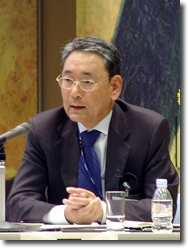
Mr. Toshio OKAZAKI
One panelist mentioned that the US and Japan differ on plutonium treatment policy: US is for burning and Japan is for breeding. He stated that the use of burning or breeding would depend on the uranium supply/demand situation and that there was no difference between burning and breeding from the viewpoint of effective utilization of natural resources.
Safeguards:
A US panelist said that enhanced Safeguards is one of seven important elements of GNEP and the advanced Safeguards system is required since minor actinide will be utilized as fuel under GNEP. In this respect, described his expectation of Japan's cooperation in this field. Because Japan is subject to IAEA Safeguards over many years, it enjoys great Safeguards experience and sophisticated Safeguards technology. In response, a Japanese panelist said that Japan has made contributions to Safeguards research and development for reprocessing and plutonium fuel facilities and is ready for further discussions in the enhanced Safeguards of GNEP.
Framework for GNEP discussions:
A US panelist observed that the details of GNEP are still under discussion, and that many countries have showed interest in GNEP, and also that, it would be very important to have frank and lively discussions on GNEP in the international arena, like this Forum.
(3) Civil Nuclear Cooperation with India:
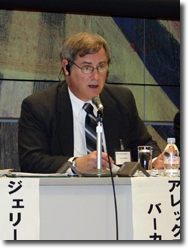
Dr. Alex BURKART
First, a US panelist explained the significance of the civil nuclear cooperation with India as follows;
- The cooperation is important in meeting the increasing energy demand in India.
- The US does not recognize India as a "nuclear weapon state" under NPT regime.
- Currently 81% of nuclear facilities in India are not placed under IAEA Safeguards; however, India has agreed to take steps that will bring her into the international nonproliferation mainstream, by placing 90 % of nuclear facilities under IAEA Safeguards in the future.
- India has committed to the IAEA Safeguards additional protocol, nuclear export control, nuclear-test moratorium, and Fissile Material Cut-off Treaty. These commitments would be a great step toward the nuclear nonproliferation mainstream. The cooperation has gained support from IAEA, UK, France and Russia.
A panelist from France, which also announced the civil nuclear cooperation with India last February, explained France's position as follows:
- France supports US cooperation with India.
- France does not recognize India as a "nuclear weapon state" under NPT.
- It is important for India to comply with nuclear nonproliferation obligations and France expects that India should sign and ratify the Comprehensive Nuclear Test Ban Treaty.
On the other hand, one panelist mentioned that he finds it difficult to conclude the pros and cons of the cooperation and that he would like to see the further discussions on implications for the NPT, the Nuclear Suppliers Group's export control guidelines and the details of IAEA Safeguards to be implemented in India.
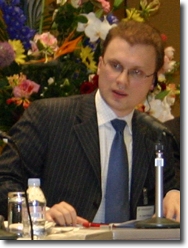
Mr. Vitaly FEDCHENKO
Areas for cooperation:
A US panelist explained that reprocessing and enrichment would be outside the scope of US cooperation, and that fast breed reactors would be outside the scope as well because they are not placed under IAEA Safeguards. Consequently, US cooperation would be limited only to light water reactors. A French panelist said that French cooperation would be almost the same as the US's. He also said that nuclear safety cooperation within a multilateral framework should be worth exploring in view of the possible effects of nuclear accidents on the international community, and added that such cooperation could be lent only to Indian nuclear facilities used exclusively for peaceful purposes.
Impacts on the NPT:
One panelist expressed his concern that civil nuclear cooperation with India could violate Article 1 and Article 3 of the NPT. The US panelist disagreed and argued that the cooperation would not violate the NPT at all, illustrating the following advantages to the nuclear nonproliferation regime;
- to help to prevent the diversion of fissile materials for military purpose, because more materials will be placed under Safeguards
- to reduce the amount of fissile material for military use
- to enhance transparency in the use of nuclear materials
Nuclear Suppliers Group (NSG) Export Control Guidelines:
A US panelist asserted that India should be the only exception of the Guidelines and Iran and DPRK should not be granted such exceptions. A French panelist said that France would never lend the civil nuclear cooperation to India before the NSG agrees on it. Another panelist pointed out the importance of the US and France not overruling NSG positions.
At the end of the panel, the chairperson summarized the panel as follows;
Assurance of nuclear fuel supply
There are various mechanisms for assuring nuclear fuel supply and following views were expressed by the panelists.
- The mechanisms would not serve as a direct solution for DPRK and Iran, however, they may be useful for the prevention of nuclear nonproliferation in the long term.
- The mechanisms need to be designed so that enrichment and reprocessing technologies are not proliferated.
- They should also be free from any political influences.
- Their proper modalities depend on how supplier states participated in the mechanisms.
US GNEP
GNEP offers nuclear energy benefits to many states which have not enjoyed them yet. Under GNEP supplier states can cooperate with recipient states in the areas of nuclear safety and nonproliferation.
The following opinions were also expressed in the panel.
- Recipient states should have the final responsibility for radioactive waste disposal.
- GNEP requires technologies with proliferation resistance and in this respect, contribution by advanced countries is expected.
- Plutonium treatment - burning or breeding - differs from state to state; however, the purpose - effective use of a natural resource - is the same.
- It is important to discuss GNEP further in the international arena.
Civil nuclear cooperation with India
It is important to increase the number of Indian nuclear facilities placed under IAEA Safeguards in order to bring India into the nuclear nonproliferation mainstream.
On the other hand, an opposing view was expressed that India should not be exempted from nonproliferation norms as an exception but that India should be treated same as many NPT states which can only enjoy peaceful use of nuclear energy in exchange for abandonment of nuclear weapon development.
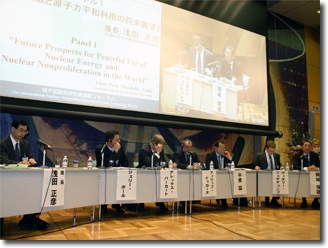
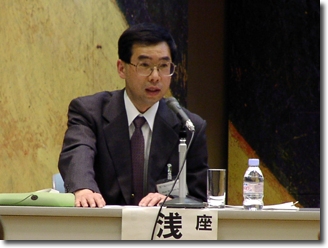
Panel 2 "Future Prospects of Nuclear Nonproliferation and Safeguards Technologies"
- Chairperson :
-
Dr. Olli HEINONEN IAEA Deputy Director General - Panelists :
-
Mr. William O'CONNOR Deputy Director, Office of Dismantlement and Transparency, Office of Defense Nuclear Nonproliferation, DOE/NNSA Mr. Maurizio BOELLA Head of Unit Concepts, Evaluation and Logistics, Directorate I (Nuclear Safeguards), Directorate-General for Energy and Transport, European Commission (EC) Mr. Kaoru NAITO President, Nuclear Material Control Center Dr. Gyungsik MIN Manager, Verification Technology Department, National Nuclear Management and Control Agency of Korea (NNCA) Mr. Masao SENZAKI Director of Nuclear Nonproliferation Science and Technology Center, JAEA
Panel 2 focused on the recent research and development efforts for ensuring effective and efficient Safeguards system as well as challenges and approaches for establishing advanced Safeguards system for the advanced nuclear fuel cycle. Each participant, including a chairperson, made his presentation, and then there was discussion among the panelists and audience.
(Note: This summary is edited by JAEA Nuclear Nonproliferation Science and Technology Center (NPSTC) on its own responsibility. Content of the summary has not been confirmation by chairperson and panelists)
Mr. Kaoru NAITO: "Nonproliferation Policy and Safeguards R&D Initiatives in Japan"
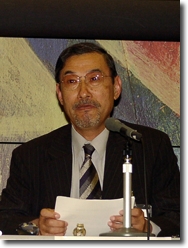
Mr. Kaoru NAITO
Mr. Naito made his presentation on Japan's nuclear nonproliferation policy, its initiatives for realizing effective and efficient IAEA Safeguards, and the advanced Safeguards technology for the Rokkasho reprocessing plant.
Japan uses nuclear energy solely for peaceful purposes under the Nuclear Nonproliferation Treaty (NPT) based on its three non-nuclear principles and the Atomic Energy Basic Law. The importance of nuclear nonproliferation is emphasized in the "Framework for Nuclear Energy Policy", which was adopted as a Cabinet resolution in October 2005.
In 1999 Japan ratified IAEA Additional Protocol and in 2004 IAEA concluded that "there was neither indication of the diversion of nuclear material placed under Safeguards nor indication of undeclared nuclear material or activities in Japan". Japan is the first case in which integrated Safeguards are implemented to a state with large-scale nuclear activities.
Japan has done its best for the realization of efficient and effective Safeguards including the development and supply of Safeguards equipment and technologies in TASTEX (Tokai Advanced Safeguards Technology Experience), LASCAR (Large Scale Reprocessing Plant Safeguards) and JASPAS (Japan Support Program for Agency Safeguards), and also additional protocol implementation trials and integrated Safeguards rehearsals.
For the Rokkasho Reprocessing Plant (RRP), advanced and large scale Safeguards are required since the plant has large throughput and handles a large quantity of plutonium around-the-clock. Based on LASCAR Projects' findings and consultations with IAEA, advanced Safeguards systems and equipments, including NRTA (Near Real Time Accountancy), solution monitoring, extended C/S (containment and surveillance) and automated data collection and evaluation, have been developed for RRP's effective and efficient Safeguards. An on-site analytical laboratory will be operated for timely chemical analysis of Safeguards samples. The Rokkasho Safeguards Center will also be operated in order to accommodate resident Safeguards inspectors and Safeguards analysts. Similar Safeguards efforts will be taken for Rokkasho MOX fuel fabrication plant (J-MOX) in the future.
Dr. Gyungsik MIN: "Introduction to Korean SSAC and Application of RMS for IAEA Safeguards"
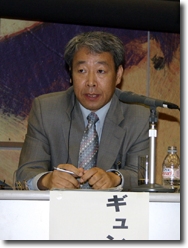
Dr. Gyungsik MIN
Dr. Min made his presentation on Korean SSAC (State Systems for Accounting and Control) and remote monitoring (RM) systems implemented for Korean light water reactors (LWRs).
In Korea, the TCNC (Technology Center for Nuclear Control) within KAERI (Korea Atomic Energy Research Institute) began Korea's inspection activities in 1977. However, a few R&D projects at KAERI failed to report the use of nuclear material in a timely manner to IAEA. Therefore, the NNCA (National Nuclear Management and Control Agency) was established as a strong and independent national nuclear control regulatory body to inspect nuclear facilities in Korea, such as LWRs, CANDU reactors and KAERI's research laboratories. NNCA's missions include monitoring the non-diversion of nuclear materials, nuclear nonproliferation, export control and improving transparency in the management of nuclear materials. A new organization, which expands the existing NNCA, will be established in July 2006.
With IAEA recommendations, remote monitoring (RM) technology has been applied to the Korean Safeguards system since 1990' as one of the technologies for strengthening IAEA Safeguards system. The introduction of the RM greatly helped IAEA to attain Safeguards goals by combining randomly selected interim inspection activities. Security and cost on RM are improved by the implementation of VPN (Virtual Private Network) and data transfer via Internet.
Mr. Maurizio BOELLA: "Status of the implementation of EURATOM Treaty Safeguards and related R&D"
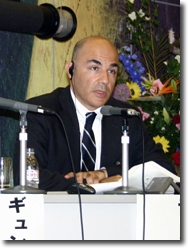
Mr. Maurizio BOELLA
Mr. Boella explained EURATOM (European Atomic Energy Community) Safeguards and related R&D activities.
EURATOM organized an expert group to review EURATOM Safeguards flexibility, improvement of effectiveness and efficiency and technology development. In April 2006, a draft document titled "Implementing European Treaty Safeguards" was issued by the expert group. The cooperation Agreement with IAEA is now being defined in accordance with the EURATOM Safeguards role.
Dr. Olli Heinonen: "R&D Priorities for the Department of Safeguards"
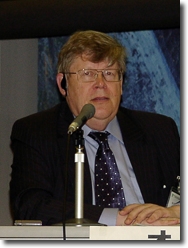
Mr. Olli Heinonen
Dr. Heinonen explained IAEA Safeguards technology R&D and Japan's contribution to the IAEA through JASPAS(Japan Support Program for Agency Safeguards).
In "the IAEA Department of Safeguards' Strategic Objectives 2006-2011", which is based on "the IAEA Medium Term Strategy 2006-2011", the following issues are identified as key priorities:
- Development of Safeguards approaches for new Safeguards challenges (ex. integrated Safeguards)
- Optimization of Safeguards equipment and technology
- Enhancement of capabilities in the area of environmental sampling
- Enhancement of the Agency's present satellite imagery acquisition and analysis capabilities
Twenty-two projects were described in the Agency's "Research and Development Programme for Nuclear Verification 2006-2007". In 2005, IAEA Department of Safeguards searched for new technologies in order to track nuclear activities. As a result, 60 proposals were identified and 5 proposals (LIBS, noble gas analysis, Lidar, OSL and Semiconductor sensors for UF6) are being developed further. The Network of Analytical Laboratories for Safeguards (NWAL) is essential to the IAEA efforts on environmental sampling. Regarding this sampling, the focus will be shifted from uranium analysis to plutonium analysis in the future. Information is the heart of modern verification; therefore, new technologies to handle large volumes of information are required in order to improve information analysis capabilities.
IAEA recognizes Japan's contribution to IAEA Safeguards through JASPAS. Japan made a substantial contribution to the establishment of the Safeguards system for Rokkasho reprocessing plant. IAEA is looking forward to Japan's future contributions including Japanese expertise in equipment development, identification of new technologies and increased support for environmental sampling analysis.
Mr. Masao SENZAKI: "Safeguards R&D at JAEA for the integrated Safeguards, detection of undeclared activities for advanced nuclear fuel cycle"
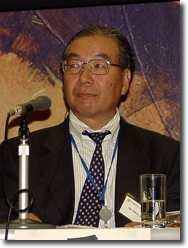
Mr. Masao SENZAKI
Mr. Senzaki made a presentation on JAEA efforts for the establishment of effective Safeguards, integrated Safeguards approach and advanced Safeguards system concepts for advanced fuel cycle facilities.
JAEA has been actively engaged in various Safeguards R&D in order to establish an effective and efficient Safeguards approach for its Tokai Reprocessing Plant (TRP), Plutonium Conversion Development Facility (PCDF), enrichment facility, MOX (mixed oxide fuel) fabrication plants and advanced reactors.
Regarding the MOX fabrication plant, design and installation of the "unattended verification system", which was developed with Los Alamos National Laboratory, was incorporated into the plant's design and construction, due to its highly-automated fabrication process. Also for MOX reactors (Joyo, Fugen and Monju), flow monitors and dual C/S R&D has been conducted. Currently, the integration of this data and the introduction of a remote monitoring system are underway.
JAEA keeps an inventory for its many nuclear facilities in a companywide system. The database of the system enables prompt legal action and also responses to inquires on nuclear materials.
The integrated Safeguards approach for nuclear cycle facilities is now being discussed with IAEA, the Japanese Government and the Japan Nuclear Material Control Center. R&D for environmental sample analysis is also now carried out at JAEA's laboratory called "CLEAR", which is certified as one of IAEA network laboratories due to its sophisticated technology.
JAEA is also studying an effective and efficient Safeguards approach for advanced fuel cycle facilities. Such Safeguards need to be implemented from early in the facility design.
Mr. William O'CONNOR: "U.S. Efforts to Advance the Safeguards "State-of-the-Art""
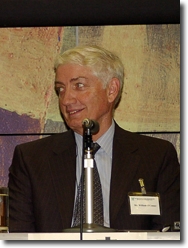
Mr. William O'CONNOR
Mr. O'Connor made a presentation on the US challenges and new approaches to state-of-the-art Safeguards.
The US has promoted R&D for Safeguards tools and methods including NDA (Non-Destructive Assay), unattended monitoring and C/S. However, in order to respond to increased need coming from large throughput facilities and advanced fuel cycle facilities (GNEP), new approaches, such as system analysis, modeling and simulation and advanced detector materials and instrumentation, are required.
Advanced measurement of uranium neutron emissions and flow rate of uranyl nitrate is currently developed in order to verify the throughput of a uranium conversion facility. Follow-on applications are expected to be used for monitoring UF6 in feed, product, and tails piping at gas centrifuge enrichment plants.
IAEA's Next Generation Surveillance System (NGSS) project will replace the existing DCM-14 with better image resolution, improved reliability and higher tolerance to radiation environments, improved remote monitoring capacity. Furthermore, advanced sealing systems, including application of the utrasonic technology and improvement of the cobra-seal function, are being developed.
As for advanced fuel cycle facilities, in particular large-scale fuel processing and fabrication facilities, efficient Safeguards approaches need to be implemented and integrated early in the facility design. Furthermore, hold-up NDA measurements must have higher accuracy, while advanced process monitoring must be combined with automated data collection and analysis.
Presentations were followed by questions and answers among panelists and the Forum audience.
- Question 1:
- Does IAEA consider introduction of plutonium isotopic composition to significant quantity (SQ)?
- Answer 1:
- The significant quantity of plutonium and uranium is reviewed whenever necessary, and current quantity (8 kg of plutonium and 25 kg of HEU) is admitted as valid by SAGSI (Standing Advisory Group on Safeguards Implementation) of the IAEA ten years ago.
- Question 2:
- Does an operator need to wait for the IAEA inspector, if the IAEA unattended monitoring equipment fails?
- Answer 2:
- In the case of RRP, inspectors are resident in the plant so they are ready to grasp the situation then take appropriate action. In addition, the recent improvement and progress of the Safeguards equipments enable to avoid such failure.
- Question 3:
- Will the Safeguards be implemented to minor actinide (MA)?
- Answer 3:
- MA accounting would not be necessary to consider, since MA is treated with plutonium. The amount of MA could be roughly counted by flow sheet verification. Further discussion would be needed for the implementation of such verification under advanced Safeguards approach.
- Question 4:
- How much Safeguards effort would be reduced by the implementation of integrated Safeguards?
- Answer 4:
- The integrated Safeguards concept for JAEA's MOX and reprocessing facilities are under discussion and the new concept has prospects of reducing significantly the Safeguards effort. If so, the concept could be applied to the J-MOX.
At the end of the panel, the chairperson summarized the panel that Safeguards R&D is essential to strengthen international nuclear nonproliferation regime and to improve Safeguards reliability. It is also important to introduce advanced Safeguards equipments and technologies for future fuel cycle facilities.
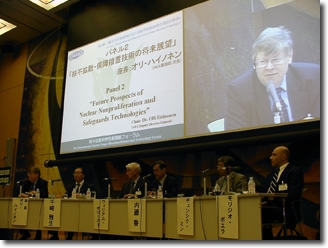
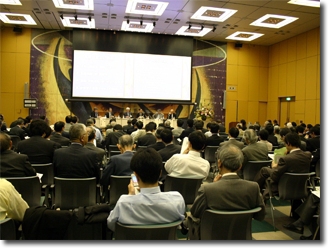
Panel 3 "Future Nuclear Cycle System and Technology Enhancing Proliferation Resistance"
- Chairperson :
-
Dr. Alex BURKART Deputy Director, Office of Nuclear Energy, Safety and Security, Bureau of International Security and Nonproliferation, US Department of States (DOS) - Panelists :
-
Mr. William O'CONNOR Deputy Director, Office of Dismantlement and Transparency, Office of Defense Nuclear Nonproliferation, DOE/NNSA Mr. Jean CAZALET Deputy Director for Development and Nuclear Innovation at the Direction for Nuclear Energy, French Atomic Energy Commission (CEA) Dr. Vladimir KAGRAMMANYAN Assistant Director General, State Scientific Center Institute of Physics and Power Engineering (IPPE) Mr. Yutaka SAGAYAMA Deputy Director General, Advanced Nuclear System Research and Development Directorate, Japan Atomic Energy Agency (JAEA)
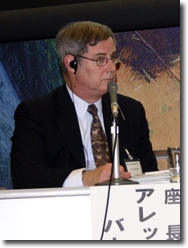
Dr. Alex BURKART
In this panel, panelists from the US, France and Japan made presentations on the current development status, plan, and nuclear proliferation resistance features of future nuclear cycle systems and technologies. These systems and technologies were studied in conjunction with GEN-IV (Generation IV Nuclear Energy System), US GNEP (Global Nuclear Energy Partnership), INPRO (International Project on Innovative Nuclear Reactors and Fuel Cycle) and Japan's Feasibility Study on Commercialized Fast Reactor Cycle Systems (FS). A Russian panelist presented a comprehensive analysis of the scenario for global nuclear energy development.
Presentations were followed by discussions on how to develop these cycles and technologies in the future, including economic efficiency and international cooperation.
(Note: This summary is edited by JAEA Nuclear Nonproliferation Science and Technology Center (NPSTC) on its own responsibility. Content of the summary has not been confirmation by chairperson and panelists)
At the beginning of the panel, the chairperson said that proliferation resistance is most frequently discussed from a technical point of view. However, in reality it is a political concept. A Russian panelist then introduced the outline of discussions on "Proliferation Resistance Fundamentals for Future Nuclear Energy Systems" at the IAEA Technical Meeting held in October, 2002, including definition, intrinsic characteristics and extrinsic measures of proliferation resistance.
- The definition of "proliferation resistance" is not uniform, but the meeting defined it as "that characteristic of a nuclear energy system that impedes the diversion or undeclared production of nuclear material, or misuse of technology, by States in order to acquire nuclear weapons or other nuclear explosive devices". In this definition, national governments are considered as proliferators and subnationals are exempted.
- The degree of proliferation resistance results from a combination of technical design features, operational modalities, institutional arrangements and Safeguards measures.
- Intrinsic proliferation resistance features are those features that result from the technical design of nuclear energy systems, including those that facilitate the implementation of extrinsic measures.
- Extrinsic proliferation resistance measures are those measures that result from States' decisions and undertakings related to nuclear energy systems.
After the introduction, the panelists made their presentations.
Dr. Burkart and Mr. O'Connor: "Global Nuclear Energy Partnership Technology Demonstration Program"

Mr. William O'CONNOR
The US GNEP is a new paradigm for the next generation of global nuclear energy and nuclear nonproliferation is a cornerstone of GNEP. Both proliferation risks by States and terrorism by subnationals are considered in GNEP. This new paradigm will incorporate nonproliferation concepts into design, and has created the technology development program. The purposes of this program are to demonstrate the key technologies in the US and to develop various technologies with international partners.
GENP will go forward through international partnership among States with common interests. International cooperation is key to GNEP success.
Mr. Cazalet: "Future nuclear cycle systems and technology enhancing proliferation resistance"
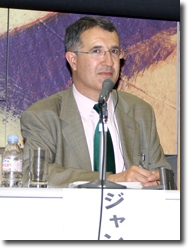
Mr. Jean CAZALET
One of essential conditions for the large expansion of nuclear energy is sustainability with the minimization of waste and radio-toxicity, the preservation of natural uranium resources and proliferation resistance. France has selected the "closed fuel cycle, fast neutron reactor" (sodium cooled fast reactor or gas cooled fast reactor) as the best nuclear energy option which fulfills this sustainability.
According to the President Chirac's statement in January 2006, CEA decided to start design work of the 4th generation prototype reactor which will be commissioned in 2020. France naturally welcomes industry or international partners who would like to get involved in this project. The "closed fuel cycle" is already an industrial reality in France.
Currently under GEN-IV, the integrated recycling namely "global actinide recycle", is delineated as a future nuclear cycle system. This is a form of actinide recycling through international cooperation. Spent fuel is reprocessed then re-fabricated in the integrated reprocessing and fabrication plant. New technologies should be implemented for this plant, such as GANEX (Global Actinide Extraction). Re-fabricated fuel is reburned in fast reactors. In this form of recycling, fission products are the only and ultimate wastes from the natural uranium and depleted uranium, since uranium, plutonium and minor actinides are all recycled. Global actinide recycling brings great advantages for nuclear nonproliferation, including reduction of proliferation risk by the minimization of transportation, recycling with non-isolated plutonium, decreasing the enrichment needs and avoiding the build-up of a "plutonium mine".
With respect to nonproliferation, comprehensive strategy and global optimization of the future systems are needed. This means that it is important to incorporate Safeguards concepts into both fuel cycles and reactor technologies, from the early design stages to operations. This is, in other words, the combination of "intrinsic" and "extrinsic" features of nuclear proliferation resistance and this approach is very similar to nuclear safety methodology.
Mr. Sagayama: "Nuclear Proliferation Resistance in Feasibility Study (FS) on Commercialized Fast Reactor Systems"
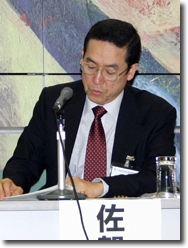
Mr. Yutaka SAGAYAMA
JAEA and Japanese electric utilities are conducting Feasibility Study on Commercialized Fast Reactor Systems (FS). Phase-II of the FS completed in March 2006 and its result is currently reviewed by the Ministry of Education, Culture, Sports, Science and Technology (MEXT). After phase-II, the FS advances to phase-III then phase-IV in order to present the promising basic design of commercialized fast reactor cycle candidates as well as to confirm their technological feasibility.
In phase-II, R&D and evaluation of several candidate concepts had been conducted based on the FS's five goals, namely safety, economic compatitiveness, reduction of environmental burden, efficent utilization of nuclea fuel resources and enhancement of proliferation resistance. For the evaluation of the proliferation resistance, the following three design requirements were set up under proliferation resistance goal;
- (1) Design for physical protection of nuclear materials and Safeguards
- (2) No isolated plutonium (no plutonium is isolated throughout the whole process)
- (3) Limited access by high exposure from lower decontaminated and/or TRU fuels
Regarding Safeguards technical requirements of (1), the advanced aqueous reprocessing, which was adopted as a promising primary reprocessing process in the FS phase-II, has a strong chance of achieving the goal. In advanced aqueous reprocessing, no plutonium is isolated through entire process. For further proliferation resistance, addition of low grade plutonium into fresh blanket fuel as well as actinide co-recovery is also studied.
Enhancing proliferation resistance is considered an important goal of future nuclear cycle systems in FS. The "extrinsic" features of proliferation resistance would be enhanced by incorporating Safeguards concepts and technologies into the advanced nuclear cycle facilities from their early design stage. In the course of the development, international cooperation is also essential in order to meet changing international circumstances on nuclear nonproliferation.
Dr. Kagramanyan: "Global nuclear energy initiatives - new opportunities for addressing non-proliferation challenges through optimum use of institutional and technical measures"
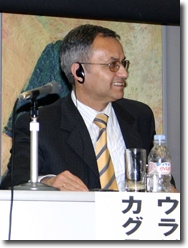
Dr. Vladimir KAGRAMMANYAN
Russia is now developing a national program of nuclear energy, including fast reactors development, and it will be finalized within a few months.
Currently, nuclear energy systems in fuel cycle countries are based on light water reactors, which is very economical and advantageous. Those cycles, however, have disadvantages including use of uranium, needs for enrichment and plutonium stockpile, which are not always favorable from economic efficiency and nuclear nonproliferation viewpoints. In order to deal with these disadvantages technically, initiatives such as GEN-IV and INPRO have been proposed. However, a technical solution is not enough for nonproliferation problems, especially mid-term problems. In order to deal with this type of problem in an institutional framework, such as multilateral international cooperation Dr. ElBaradei's Multilateral Nuclear Approaches (MNA) and President Putin's initiative of international fuel cycle centers have been proposed. I do believe, however, that none of these initiatives can the disadvantages. The most promising approach today would be a combination of GNEP's institutional approach of a Consortium which would include traditional French reprocessing and Russian fast reactors. In this respect, I understand that the development and construction of fast reactors needs to be accelerated.
Nuclear nonproliferation requirements to nuclear energy differ according to technologies, countries and their global visions. Under these circumstances, every country needs to discuss and collaborate toward global interests by considering these differences.
Presentations were followed by questions and answers among panelists including the forum audience.
- Question 1:
- What are objectives of enhancing proliferation resistance in the advanced fuel cycle technologies? What threats are assumed?
- Answer 1:
-
- The objectives vary according to the different states' nuclear programs (nuclear weapon states or non-nuclear weapon states). It also depends on how long the program has been around. They are different in weapon states and non-weapon states.
- Development of advanced Safeguards technology for the whole GNEP fuel cycle is one of one of GNEP's seven elements in its implementation strategy. In this regards, it is the IAEA who decides how Safeguards would be implemented in advanced fuel cycle facilities. Furthermore, it is important to incorporate Safeguards concepts into advanced fuel cycle facilities from their concept design stage.
- Question 2:
- What is the difference between GEN-IV and GNEP?
- Answer 2:
-
- The former is long-term program for advanced fuel cycle technologies R&D, while the latter is near-term program for building systems and technologies. For example, the advanced burner reactor (ABR) is a development target under GNEP, while the sodium fast breeder reactor is a target in GEN-IV. Interactions of these two initiatives would create great benefits to the global community.
- The target reactors are different; however, both are technically similar in terms of fast neutron reactor, and both initiatives complement each other.
- Question 3:
- Aren't proliferation resistance and economic efficiency contradictory each other?
- Answer 3:
-
- Advanced fuel cycles need to be economically efficient therefore; economic efficiency is one of development goals.
- The best combination of intrinsic and extrinsic features of proliferation resistance may contribute economic efficiency.
- For example, a high burn-up reactor contributes to both economic efficiency and proliferation resistance. In addition, the higher the number of fast reactors constructed, the more the competition would increase.
- Question 4:
- What states could be GNEP partners?
- Answer 4:
- According to the United States, partners for separation technologies would be limited to those who already have a full-scale reprocessing plant. However, for other technologies, US will search partners depending on context. As a result, we believe we will reduce the total cost through cooperation.
- Question 5:
- How much proliferation resistance is enough? Is there a limit?
- Answer 5:
- This discussion is similar to the discussion on nuclear safety methodology. Certain risks need to be accepted, if we use nuclear energy, since anything involves a certain degree of risk. The level of acceptable risk varies according to the state, circumstances and time.
- Question 6:
- Under the GNEP initiative, transportation of spent fuel from recipient states to supplier states would increase. Doesn't this cause problem from the nuclear nonproliferation viewpoint, as if creating of "plutonium pipeline"?
- Answer 6:
- The frequency and operation time of transportation will be limited and they can be fully monitored from the beginning to the end, using both intrinsic features and extrinsic measures.
At the end of the panel, the chairperson, Dr. Burkart, concluded that we needed more and more forums to discuss the various topics, in order to obtain the final conclusion on proliferation resistance issues. This discussion will continue in the future.
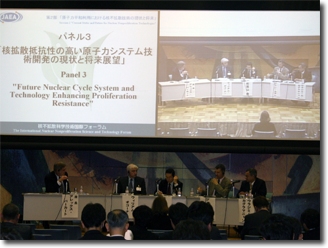
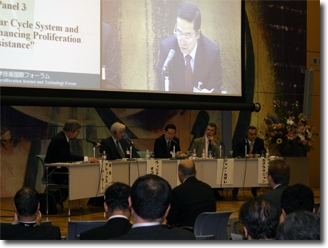
Closing Remarks
Mr. Toshio OKAZAKI, JAEA Executive Vice President, delivered following closing remarks at the end of the Forum;
I would like to extend my appreciation to distinguished experts of the world for having discussed various nuclear nonproliferation issues from a wide range of perspectives. During the Forum, a lot of opinions and suggestions were expressed regarding what the international society should do together in order to deal with nuclear nonproliferation issues which might violate world peace and security. I felt that the enthusiasm and heated discussion during the Forum must be comparable with that of President Eisenhower's speech on "Atoms for Peace" in the UN General Assembly in New York for 50 years ago and of INFCE (International Nuclear Fuel Cycle Evaluation) for 25 years ago.
I expect that the discussion during the Forum would become the foundation of the development for the compatibility of the peaceful use of nuclear energy and nuclear nonproliferation and consequently serve for the world peace and development. I reaffirm my determination that JAEA will continue to contribute to the peaceful use of nuclear energy and to nuclear nonproliferation.
